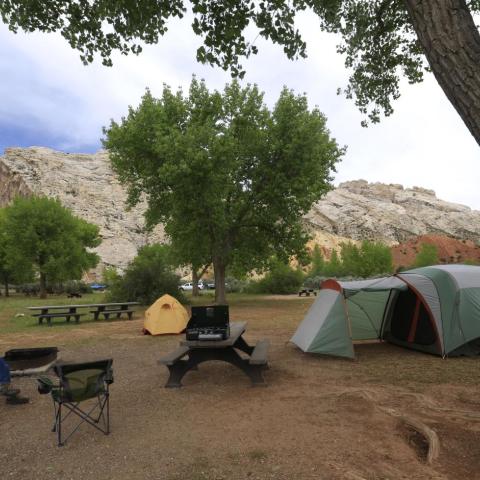Trying to understand how Interior Secretary Ryan Zinke views himself as a conservationist cut from the mold of Theodore Roosevelt is an ongoing challenge. While he wants to bolster the ranks of hunters and anglers, the secretary also wants to shrink some national monuments, allow target shooting on as many public lands as possible, and allow hunters to chum for bears with donuts and greasy loaves of bread.
Secretary Zinke also would toss out an historic agreement aimed at preserving the greater sage grouse and wants to hasten more energy development on public lands even though "(T)hrough the 2015 fiscal year, a record 7,950 drilling permits on federal leases were not being used."
In pro-Trump Utah, the U.S. Bureau of Land Management is being driven by Interior officials to open up more lands for energy development. The agency has gotten so driven that even the Republican governor, Gary Herbert, has asked the BLM to reevaluate its decision to offer leases close to Dinosaur National Monument to "ensure energy developments can successfully coexist with outdoor recreation."
Under Secretary Zinke, the National Park Service did away with a ban on the sale of disposable plastic bottles and scuttled a director's order signed by former Park Service Director Jon Jarvis last year that reaffirmed the agency's “predominant” duty as protecting natural and cultural resources.
With such actions, one has to wonder if Mr. Zinke recalls President Roosevelt's statement that, "(T)he nation behaves well if it treats the natural resources as assets which it must turn over to the next generation increased and not impaired in value."
Mr. Zinke's latest questionable move was a secretarial order he signed Friday to "support sportsmen and enhance wildlife conservation." The order came eight days after the U.S. Fish and Wildlife Service released a report noting that "more than 101 million Americans – a staggering 40 percent of the U.S. population – participated in some form of fishing, hunting, or other wildlife-associated recreation such as birdwatching or outdoor photography."
What caught the attention of the Theodore Roosevelt Conservation Partnership in the report that same day was that the ranks of hunters had declined by 2.2 million since 2011. Secretary Zinke mentioned that Friday in his secretarial order, which he said would aim to "improve wildlife management and conservation, increase access to public lands for hunting, shooting, and fishing, and put a new and a greater emphasis on recruiting and retaining new sportsmen conservationists."
Hunting and fishing have long traditions in America, and concern over the slow decline in hunters is not new. The cause has been parsed by many. Google "decline in hunting" and you'll get 36 million results in less than a second. Some who have analyzed this dilemma have pointed to the growing costs of hunting, the shrinkage of lands to hunt on, the urbanization of the United States, and a lack of interest among younger generations to hunt. The methods used by Fish and Wildlife Service staff to produce these studies also have been questioned, with some in Alaska saying the numbers for their state are dead wrong.
(It shouldn't go unnoted that so concerned are some in Congress about the decline in hunting that the House is considering the questionably labeled Sportsmen’s Heritage And Recreational Enhancement Act that would allow hunters to use armor-piercing bullets and silencers on their weapons.)
Whatever the cause, Mr. Zinke wants to reverse the decline in hunting and is trying everything he possibly can to do so, including quoting President Roosevelt in his order: "In a civilized and cultivated country, wild animals only continue to exist at all when preserved by sportsmen."
Now, across the National Park System, there are myriad destinations for hunters and anglers, whether you want to pursue waterfowl at Cape Hatteras or Cape Lookout national seashores in North Carolina, wild turkeys at Cape Cod National Seashore in Massachusetts, feral pigs or deer at Cumberland Island National Seashore in Georgia or Big Thicket National Preserve (which also has seasons for squirrels, rabbits, and waterfowl) in Texas, or dall sheep and moose in Denali National Park and Preserve in Alaska. And the list goes on. It gets longer when you consider fishing in the park system.
But the secretary wants more access and opportunities, and in his order directed those within the National Park Service and Bureau of Land Management who oversee national monuments to "amend National Monument Management Plans to include or expand hunting, recreational shooting, and fishing opportunities" where possible.
And that provision caught the attention of park advocates.
"This Secretarial Order is a solution in search of a problem," said Kristen Brengel, vice president of government affairs for the National Parks Conservation Association (and a board member of National Parks Traveler). "Our national parks continue to welcome visitors in record-setting numbers to enjoy camping, fishing, hiking, wildlife-viewing, and countless other activities. Not to mention that, from Cape Hatteras National Seashore to Mojave National Preserve, more than 60 of our national park sites currently offer hunting opportunities within park boundaries, and countless sites offer fishing.
“As Secretary Zinke’s press release states, a new U.S. Fish and Wildlife Service survey found 2.2 million fewer hunters in America now than in 2011," she added. "On the other hand, our national parks have seen a 13 percent increase in visitors over the past two years, and welcomed a record-setting 331 million people in 2016. Supply and demand tells us there are already plenty of opportunities for sportsmen and women on millions of acres of public lands. Instead, Secretary Zinke should consider adding more national parks and monuments to the system to meet the public’s increased demand.”
At the Coalition to Protect America's National Parks, Maureen Finnerty not only couldn't think of any hunting or fishing access problems in the National Park System, but wondered if the secretary's order violates "the proclamation orders or legislation that established" national monuments.
"Nowhere in the order is there any discussion of the impact of these activities on the resource," Ms. Finnerty added. "This seems to be a consistent troubling trend of this administration – they promote lots of activities and initiatives, but have shown no concern for the impact of any of them on park resources."
The secretary's desire to see national monuments opened up to target shooting is particularly curious. Considering all the petroglyphs and pictographs in the Southwest that have served as targets over the decades, is this really a good idea? In Utah, one of many states with reports of rock art serving as targets, the BLM last December decided to close 2,000 acres to target shooting in part because of "trigger trash."
Beyond that, while wildfires have plagued the West this summer, prompting Secretary Zinke to tell public land managers that they should contract private companies to reduce fuel loads if they can't handle it, more than a few wildfires have been sparked by target shooting on public lands.
In California, the issue has prompted state officials to urge target shooters to practice their aim "in areas free of dry vegetation — and avoid shooting on hot windy days," conditions not always found on public lands. And in Nevada, officials from Humboldt-Toiyabe National Forest have expressed concern over target shooting and wildfires.
Frankly, it's not clear that the public landscape can handle such an approach to conservation as Secretary Zinke would like to see when it comes to energy development, baiting bears, target shooting, what's best for sage grouse, and his general views on "public-private partnerships" on public lands.






 Support Essential Coverage of Essential Places
Support Essential Coverage of Essential Places







Comments
There are very few petroglyph panels anywhere in Utah that are not pockmarked with bullet holes. (Traffic signs and outhouse doors, too.)
It's also a rather interesting experience to be out in some wild place and hear gunshots echoing from somewhere. It's even more interesting to begin to hear the unmistakable whistle of bullets passing by. And yes, I know many people besides me who have had that thrilling experience. In fact, long ago I twice came home from flying with bullet holes in the airplane. Someone on the ground took potshots at the plane while I was in the airport traffic pattern at low altitude. Other pilots have had the same experience.
But hey, isn't a gun for shooting? Don't y'need a target of some kind?
https://www.nationalparkstraveler.org/potw/poor-choice-target-practice-d...
Unfortunately, I'm afraid most of the commentary on this topic will fall on partisan lines.
Hmmm. Sounds to me, Lee, like you were the target. Or rather, your plane was the target. I'm guessing the shooter was either too broke to afford the fee to use an official indoor or outdoor shooting range, or the shooter was just plain stupid ... or both.
Likely stupid and bored. Both times my planes were hit it was over a wooded area surrounding our little grass strip in Ohio many years ago.
Then just a few months ago, I was camping in a Forest Service campground -- Monte Cristo on the Wasatch - Cache forest east of Ogden, Utah when someone opened up some distance away with a semi-automatic heavy caliber of some kind. Bullets were clipping through treetops in the campground and cutting leaves from branches. Several of us campers laid on our vehicle horns trying to get the message out that we were in the way. After firing perhaps 50 rounds, the shooting stopped. When it began again, the bullets were not coming our way. A woman from an adjoining campsite drove off to find cell service and call the sheriff. I don't know if law enforcement ever responded or not. Two men drove off to try to find the shooters, but failed and returned to camp after the shooting stopped.
A few years ago, down in southern Utah I was hiking the Paria Narrows with a youth group. We were in a boulder field when we began hearing gunshots and had bullets plunking into boulders all around us. We shouted as loud as we could and after a few more shots we heard someone shout, "Sorry!" The shooting stopped, but we never did see who had been behind the gun. I don't believe either this incident nor the one on Monte Cristo were deliberate. Just some people shooting for recreation without adequate thought or precautions.
Also, all the wooden restrooms that were at the Paria trailhead in those days looked like Swiss cheese as we started out on our hike. Do we really want to see any of our national parks or monuments opened to such things?
I have heard similar stories from many other people. I'm sure other Traveler readers can tell stories of their own.
In the meantime, here's one other item related to Zinke's plans for our public lands. This is from today's Salt Lake Tribune: http://www.sltrib.com/news/environment/2017/09/17/utah-quietly-tells-fed...
At the risk of sounding alarmist, I'm afraid it will simply be a matter of "when", not "if" someone in a national park gets hurt. The parks are becoming more and more crowded (think: 1 million visitors at Glacier National Park in July, alone), and the thought of target practice someplace like that makes me think I'll have to start wearing a bright orange traffic vest in addition to the bright shirts I already wear when out and about with my photography.
Just be sure your bright orange vest is made of Kevlar.
Besides being a poor conservationist, it appears Secretary Zinke is also a terrible manager.
"While reassignments of individual senior executives are encouraged to provide broad experience, mass transfers of this magnitude ["dozens"] are unheard of. And given the scarcity of confirmed political appointees at the department, Interior Secretary Ryan Zinke’s reassignment of more than 20 percent of the senior executive corps could be particularly disruptive. Out of 18 presidentially appointed slots requiring Senate confirmation at Interior, only three are filled, per data from The Washington Post/Partnership for Public Service tracker. Of six assistant secretary offices, which work directly with senior executives, none is filled."
https://www.washingtonpost.com/news/powerpost/wp/2017/09/12/interiors-un...
You still don't get it. The Trump administration isn't going to do things the way the prior administrations have. That is not terrible management, it is why Trump was elected.